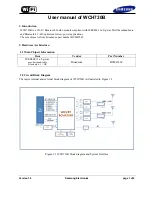
66
Glossary
●
3G
— Third Generation. 3G refers to the third generation of mobile telephony technology. 3G
telecommunication networks support services that provide an information transfer rate of at least 200
kbit/s. However, many services advertised as 3G provide higher speed than the minimum technical
requirements for a 3G service. 3G finds application in wireless voice telephony, mobile Internet access,
fixed wireless Internet access, video calls and mobile TV.
●
4G LTE
— Fourth Generation Long Term Evolution. LTE is a standard for wireless data communications
technology and an evolution of the UMTS standards. The goal of LTE is to increase the capacity
and speed of wireless data networks using new DSP (digital signal processing) techniques and
modulations that were developed around the turn of the millenium. A further goal is the redesign and
simplification of the network architecture to an IP-based system with significantly reduced transfer
latency compared to the 3G architecture. The LTE wireless interface is incompatible with 2G and 3G
networks, so that it must be operated on a separate wireless spectrum.
●
802.11 (a, b, g, n
, ac
)
— A set of WLAN communication standards in the 2.4, 3.6 and 5 GHz frequency
bands.
●
bps
— Bits per second. The rate of data flow.
●
Broadband
— High-capacity high-speed transmission channel with a wider bandwidth than
conventional modem lines. Broadband channels can carry video, voice, and data simultaneously.
●
DHCP
— Dynamic Host Configuration Protocol. Software found in servers and routers that
automatically assigns temporary IP addresses to clients logging into an IP network.
●
DHCP Server
— A server or service with a server that assigns IP addresses.
●
DNS
— Domain Name System. A system for converting host names and domain names into IP
addresses on the Internet or on local networks that use the TCP/IP protocol.
●
Firmware
— A computer program embedded in an electronic device. Firmware usually contains
operating code for the device.
●
GB
— Gigabyte. A multiple of the unit byte for digital information storage. Usage depends on context.
When referring to disk capacities it usually means 10
9
bytes. It also applies to data transmission
quantities over telecommunication circuits.
●
Hotspot
— A Wi-Fi (802.11) access point or the area covered by an access point. Used for connecting
to the Internet.
●
HTTP
— Hypertext Transfer Protocol. An application-level protocol for accessing the World Wide Web
over the Internet.
●
IEEE —
Institute of Electrical and Electronics Engineers. An international technical/professional society
that promotes standardization in technical disciplines.
●
IMEI
— International Mobile Equipment Identity. Used in LTE networks to identify the device. It is
usually printed on the device and can often be retrieved using a USSD code.
●
IP
— Internet Protocol. The mechanism by which packets are routed between computers on a
network.



































